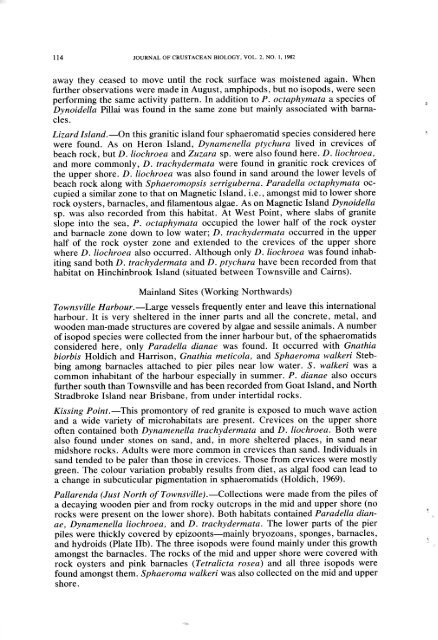Download PDF as one large file
Download PDF as one large file
Download PDF as one large file
You also want an ePaper? Increase the reach of your titles
YUMPU automatically turns print PDFs into web optimized ePapers that Google loves.
114 JOURNAL OF CRUSTACEAN BIOLOGY, VOL. 2, NO. 1, 1982<br />
away they ce<strong>as</strong>ed to move until the rock surface w<strong>as</strong> moistened again. When<br />
further observations were made in August, amphipods, but no isopods, were seen<br />
performing the same activity pattern. In addition to P. octaphymata a species of<br />
Dynoidella Pillai w<strong>as</strong> found in the same z<strong>one</strong> but mainly <strong>as</strong>sociated with barnacles.<br />
Lizard Island.—On this granitic island four sphaeromatid species considered here<br />
were found. As on Heron Island, Dynamenella ptychura lived in crevices of<br />
beach rock, but D. liochroea and Zuzara sp. were also found here. D. liochroea,<br />
and more commonly, D. trachydermata were found in granitic rock crevices of<br />
the upper shore. D. liochroea w<strong>as</strong> also found in sand around the lower levels of<br />
beach rock along with Sphaeromopsis serriguberna. Paradella octaphymata occupied<br />
a similar z<strong>one</strong> to that on Magnetic Island, i.e., amongst mid to lower shore<br />
rock oysters, barnacles, and filamentous algae. As on Magnetic Island Dynoidella<br />
sp. w<strong>as</strong> also recorded from this habitat. At West Point, where slabs of granite<br />
slope into the sea, P. octaphymata occupied the lower half of the rock oyster<br />
and barnacle z<strong>one</strong> down to low water; D. trachydermata occurred in the upper<br />
half of the rock oyster z<strong>one</strong> and extended to the crevices of the upper shore<br />
where D. liochroea also occurred. Although only D. liochroea w<strong>as</strong> found inhabiting<br />
sand both D. trachydermata and D. ptychura have been recorded from that<br />
habitat on Hinchinbrook Island (situated between Townsville and Cairns).<br />
Mainland Sites (Working Northwards)<br />
Townsville Harbour.—Large vessels frequently enter and leave this international<br />
harbour. It is very sheltered in the inner parts and all the concrete, metal, and<br />
wooden man-made structures are covered by algae and sessile animals. A number<br />
of isopod species were collected from the inner harbour but, of the sphaeromatids<br />
considered here, only Paradella dianae w<strong>as</strong> found. It occurred with Gnathia<br />
biorbis Holdich and Harrison, Gnathia meticola, and Sphaeroma walkeri Stebbing<br />
among barnacles attached to pier piles near low water. S. walkeri w<strong>as</strong> a<br />
common inhabitant of the harbour especially in summer. P. dianae also occurs<br />
further south than Townsville and h<strong>as</strong> been recorded from Goat Island, and North<br />
Stradbroke Island near Brisbane, from under intertidal rocks.<br />
Kissing Point.—This promontory of red granite is exposed to much wave action<br />
and a wide variety of microhabitats are present. Crevices on the upper shore<br />
often contained both Dynamenella trachydermata and D. liochroea. Both were<br />
also found under st<strong>one</strong>s on sand, and, in more sheltered places, in sand near<br />
midshore rocks. Adults were more common in crevices than sand. Individuals in<br />
sand tended to be paler than those in crevices. Those from crevices were mostly<br />
green. The colour variation probably results from diet, <strong>as</strong> algal food can lead to<br />
a change in subcuticular pigmentation in sphaeromatids (Holdich, 1969).<br />
Pallarenda (Just North ofTownsville).—Collections were made from the piles of<br />
a decaying wooden pier and from rocky outcrops in the mid and upper shore (no<br />
rocks were present on the lower shore). Both habitats contained Paradella dianae,<br />
Dynamenella liochroea, and D. trachydermata. The lower parts of the pier<br />
piles were thickly covered by epizoonts—mainly bryozoans, sponges, barnacles,<br />
and hydroids (Plate lib). The three isopods were found mainly under this growth<br />
amongst the barnacles. The rocks of the mid and upper shore were covered with<br />
rock oysters and pink barnacles (Tetralicta rosea) and all three isopods were<br />
found amongst them. Sphaeroma walkeri w<strong>as</strong> also collected on the mid and upper<br />
shore.

















